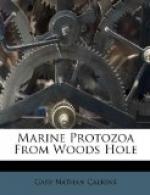The body is cylindrical to pyriform, in the latter case broadened anteriorly. Cuticle distinctly marked by longitudinal striations which take the form of depressions and give to the body a characteristic melon shape. The endoplasm contains a number of large refringent granules—probably body products. The nucleus is elongate, somewhat curved, and coarsely granular. A micronucleus lies in the concavity. The cilia are long, inserted rather widely apart along the longitudinal markings. The contractile vacuole is single and is located at the pointed end, which is directed backwards during locomotion. One specimen found free swimming among some algae.
Length 104 mu; greatest diameter 36 mu.
I was much surprised to find this form swimming about freely in the water; its mouthless condition showed it to belong to the family of parasites, the Opalinidae. As the name indicates, however, this species is an ectoparasite upon the gills, and Stein gave the name branchiarum to a fresh-water form parasitic upon Gammarus pulex. The Woods Hole form is so strikingly similar to the figure of G. branchiarum that, although the name was given to a fresh-water form, it obviously applies to this marine variety. One important difference is the presence of only one contractile vacuole in the marine form.
[Illustration: Fig. 44.—Anoplophrya branchiarum.]
KEY TO FAMILIES OF HETEROTRICHIDA.
Cilia cover the body 1
Cilia reduced to certain 2
localized areas
1. Polytrichina.
a. The mouth terminates a long
Family Plagiotomidae
peristomial furrow
having an
adoral zone along
the entire
left edge
b. Peristomial area a broad
Family Bursaridae
triangular area
ending in mouth
c. Peristomial depression short;
Family Stentoridae
limited to the
anterior end; its
plane at right
angles to the
long axis of body;
surface of
peristome striated
and ciliated;
no undulating
membranes
2. Oligotrichina.
a. Peristome without cilia;
cilia Family Halteriidae
limited to one
or more girdles
about body
One marine genus *_Strombidium_
b. Thecate forms; the body
is Family Tintinnidae
attached by a
stalk to the cup;
within the adoral
zone is a ring
of cilia.
c. The peristomial depression
is Family Ophryoscolecidae
deep and funnel-like;
cuticle
thick, with posterior
spine-like
processes.
* Presence at Woods Hole indicated by asterisk.




